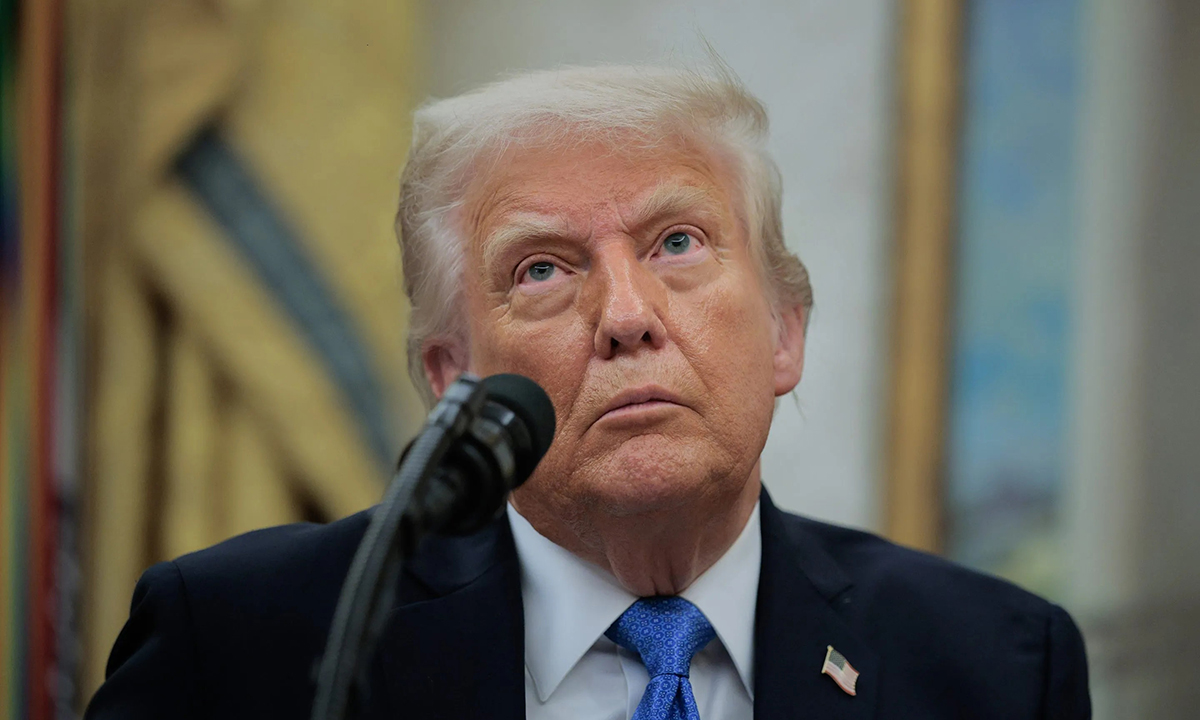
? 美國國債激增,,當(dāng)前已突破36.2萬億美元,引發(fā)經(jīng)濟(jì)學(xué)家及穆迪(Moody’s)等評級機構(gòu)的日益擔(dān)憂,。穆迪近期下調(diào)美國信用評級,,核心憂慮在于經(jīng)濟(jì)增長速度跟不上債務(wù)與利息支出的攀升速度。
經(jīng)濟(jì)學(xué)家批評政界提出的減債計劃力度不足且為時已晚,。但分析人士警示,,這一隱患正逐漸反噬美國經(jīng)濟(jì)——對美國未來財政前景曾經(jīng)堅不可摧的信心已開始瓦解。
美國的國債規(guī)模如今超過36.2萬億美元,,正日益引起經(jīng)濟(jì)學(xué)家們的擔(dān)憂,。他們擔(dān)心,隨著國家債務(wù)負(fù)擔(dān)及償債利息支出同步攀升,,美國經(jīng)濟(jì)增速將不足以維持財政開支,。
此類擔(dān)憂在穆迪上周將美國信用評級從Aaa下調(diào)至Aa1的舉動中得到印證。穆迪解釋稱:“盡管我們承認(rèn)美國具有強大的經(jīng)濟(jì)金融實力,,但我們認(rèn)為這些優(yōu)勢已不足以完全抵消財政指標(biāo)的惡化,。”
盡管美國財長斯科特·貝森特宣稱市場無需過度關(guān)注穆迪的評級調(diào)整,,但此次降級仍為美國財政健康再添隱憂,。
正如德意志銀行(Deutsche Bank)分析師吉姆·里德今晨向《財富》雜志提供的分析報告中所說:“昨日美國財政狀況正處在‘被千刀萬剮的死亡’邊緣。雖難以判斷我們正遭遇千刀中的第幾刀,,但顯然我們的痛苦更接近終點而非起點,,盡管盤中拋售潮最終出現(xiàn)逆轉(zhuǎn)?!?/p>
“歸根結(jié)底,,美國在周五深夜失去最后一個AAA評級不會立即引發(fā)劇變,但持續(xù)不斷的負(fù)面財政消息正不斷沖擊債務(wù)可持續(xù)性的堤壩,?!?/p>
特朗普總統(tǒng)和他的內(nèi)閣并非對國債問題視而不見。特朗普提議通過“金卡”簽證計劃籌措償債資金,,而政府效率部(DOGE)則始終強調(diào)效率提升與成本削減,。
但特朗普在兌現(xiàn)競選承諾時維持著微妙平衡:既要削減開支又要降低稅負(fù),而這反過來會減少重新平衡政府支出所需的財政收入,。
特朗普政府正力推國會通過這項“宏大而美好”的減稅法案,。其中部分內(nèi)容涉及延長2017年的減稅政策(該政策將于2025年底到期),新增條款包括取消小費與加班收入稅等亮點,。
特朗普政府聲稱該法案實際上有助于重塑債務(wù)與GDP比率,。為了實現(xiàn)財政平衡,政府有兩個選擇:要么削減債務(wù),,要么提升GDP,。
他們主張延長減稅政策將促進(jìn)后者,聲稱法案可使短期實際GDP增長3.3%-3.8%,,長期實際GDP增長2.6%-3.2%,。
但國會預(yù)算辦公室(Congressional Budget Office,CBO)對此持有異議,。該無黨派分析機構(gòu)4月份的一份報告中指出,,若2017年減稅政策延期導(dǎo)致稅收減少,且財政政策不做其他調(diào)整,,到2025年公共債務(wù)將達(dá)到GDP的220%,。
這較未實施減稅措施的長期基準(zhǔn)預(yù)測值高出63個百分點。
寄希望于美聯(lián)儲
若美國債務(wù)買家對政府償債能力失去信心,,美聯(lián)儲將成為最后的救命稻草,。
央行可能采取引發(fā)爭議的量化寬松政策來壓低長期利率,為政府持續(xù)舉債創(chuàng)造便利,。
盡管債市對穆迪降級反應(yīng)平淡,,但瑞銀(UBS)指出,,若市場波動加劇,美聯(lián)儲或?qū)⒊鍪指深A(yù),。
瑞銀首席投資官馬克·海菲爾今日在提供給《財富》雜志的報告中表示:“總體而言,,我們認(rèn)為此次評級調(diào)整屬于頭條風(fēng)險,而非市場根本性轉(zhuǎn)折,。若債券收益率出現(xiàn)無序或不可持續(xù)的飆升,,我們預(yù)計美聯(lián)儲將會介入?!?/p>
“因此,,盡管降級可能削弱近期部分‘利好’勢頭,但我們預(yù)計其不會對金融市場產(chǎn)生重大直接影響,?!保ㄘ敻恢形木W(wǎng))
譯者:劉進(jìn)龍
審校:汪皓
? 美國國債激增,當(dāng)前已突破36.2萬億美元,,引發(fā)經(jīng)濟(jì)學(xué)家及穆迪(Moody’s)等評級機構(gòu)的日益擔(dān)憂,。穆迪近期下調(diào)美國信用評級,核心憂慮在于經(jīng)濟(jì)增長速度跟不上債務(wù)與利息支出的攀升速度,。
經(jīng)濟(jì)學(xué)家批評政界提出的減債計劃力度不足且為時已晚,。但分析人士警示,這一隱患正逐漸反噬美國經(jīng)濟(jì)——對美國未來財政前景曾經(jīng)堅不可摧的信心已開始瓦解,。
美國的國債規(guī)模如今超過36.2萬億美元,,正日益引起經(jīng)濟(jì)學(xué)家們的擔(dān)憂。他們擔(dān)心,,隨著國家債務(wù)負(fù)擔(dān)及償債利息支出同步攀升,,美國經(jīng)濟(jì)增速將不足以維持財政開支。
此類擔(dān)憂在穆迪上周將美國信用評級從Aaa下調(diào)至Aa1的舉動中得到印證,。穆迪解釋稱:“盡管我們承認(rèn)美國具有強大的經(jīng)濟(jì)金融實力,,但我們認(rèn)為這些優(yōu)勢已不足以完全抵消財政指標(biāo)的惡化?!?/p>
盡管美國財長斯科特·貝森特宣稱市場無需過度關(guān)注穆迪的評級調(diào)整,,但此次降級仍為美國財政健康再添隱憂。
正如德意志銀行(Deutsche Bank)分析師吉姆·里德今晨向《財富》雜志提供的分析報告中所說:“昨日美國財政狀況正處在‘被千刀萬剮的死亡’邊緣,。雖難以判斷我們正遭遇千刀中的第幾刀,,但顯然我們的痛苦更接近終點而非起點,盡管盤中拋售潮最終出現(xiàn)逆轉(zhuǎn),?!?/p>
“歸根結(jié)底,美國在周五深夜失去最后一個AAA評級不會立即引發(fā)劇變,,但持續(xù)不斷的負(fù)面財政消息正不斷沖擊債務(wù)可持續(xù)性的堤壩,?!?/p>
特朗普總統(tǒng)和他的內(nèi)閣并非對國債問題視而不見。特朗普提議通過“金卡”簽證計劃籌措償債資金,,而政府效率部(DOGE)則始終強調(diào)效率提升與成本削減,。
但特朗普在兌現(xiàn)競選承諾時維持著微妙平衡:既要削減開支又要降低稅負(fù),而這反過來會減少重新平衡政府支出所需的財政收入,。
特朗普政府正力推國會通過這項“宏大而美好”的減稅法案。其中部分內(nèi)容涉及延長2017年的減稅政策(該政策將于2025年底到期),,新增條款包括取消小費與加班收入稅等亮點,。
特朗普政府聲稱該法案實際上有助于重塑債務(wù)與GDP比率。為了實現(xiàn)財政平衡,,政府有兩個選擇:要么削減債務(wù),,要么提升GDP。
他們主張延長減稅政策將促進(jìn)后者,,聲稱法案可使短期實際GDP增長3.3%-3.8%,,長期實際GDP增長2.6%-3.2%。
但國會預(yù)算辦公室(Congressional Budget Office,,CBO)對此持有異議,。該無黨派分析機構(gòu)4月份的一份報告中指出,若2017年減稅政策延期導(dǎo)致稅收減少,,且財政政策不做其他調(diào)整,,到2025年公共債務(wù)將達(dá)到GDP的220%。
這較未實施減稅措施的長期基準(zhǔn)預(yù)測值高出63個百分點,。
寄希望于美聯(lián)儲
若美國債務(wù)買家對政府償債能力失去信心,,美聯(lián)儲將成為最后的救命稻草。
央行可能采取引發(fā)爭議的量化寬松政策來壓低長期利率,,為政府持續(xù)舉債創(chuàng)造便利,。
盡管債市對穆迪降級反應(yīng)平淡,但瑞銀(UBS)指出,,若市場波動加劇,,美聯(lián)儲或?qū)⒊鍪指深A(yù)。
瑞銀首席投資官馬克·海菲爾今日在提供給《財富》雜志的報告中表示:“總體而言,,我們認(rèn)為此次評級調(diào)整屬于頭條風(fēng)險,,而非市場根本性轉(zhuǎn)折。若債券收益率出現(xiàn)無序或不可持續(xù)的飆升,,我們預(yù)計美聯(lián)儲將會介入,。”
“因此,,盡管降級可能削弱近期部分‘利好’勢頭,,但我們預(yù)計其不會對金融市場產(chǎn)生重大直接影響,。”(財富中文網(wǎng))
譯者:劉進(jìn)龍
審校:汪皓
? America’s soaring national debt, now over $36.2 trillion, has triggered growing concern among economists and credit agencies like Moody’s, which recently downgraded the U.S. credit rating amid fears that economic growth won’t keep pace with rising debt and interest payments.
Economists have criticized politicians’ plans to reduce America’s national debt as too little, too late. But analysts are warning that the issue is now coming home to roost, with the once unshakeable confidence in the United States’ fiscal future beginning to erode.
America’s national debt, which currently stands at more than $36.2 trillion, is increasingly rising on economists’ agendas. Their fear is that as the nation’s debt burden increases, alongside the interest payments to service the debt, the economy will not grow fast enough to sustain the spending.
Such fears were reflected in a Moody’s downgrade of U.S. credit last week from Aaa to Aa1. Moody’s justified: “While we recognize the US’ significant economic and financial strengths, we believe these no longer fully counterbalance the decline in fiscal metrics.”
The downgrade is yet another thorn in the side of America’s fiscal health, despite protestations from Treasury Secretary Scott Bessent that the market should take little heed of Moody’s news.
As Deutsche Bank’s Jim Reid put it in a note seen by Fortune this morning: “Yesterday felt like we were somewhere along the line of a ‘death by a thousand cuts’ with regards to the U.S. fiscal situation. Hard to know where in that thousand we are but probably much nearer a thousand than at zero even as yesterday saw an initial sell-off reverse as the session went on.
“At the end of the day the loss of the final U.S. triple-A rating late on Friday night doesn’t change anything much immediately but it keeps the drip, drip, drip of poor fiscal news building up against the debt sustainability dam in the background.”
President Trump and his cabinet are not blind to the national debt issue. Trump has suggested it could be paid off with the funds from his ‘gold card’ visa scheme, while the overriding message from DOGE (the Department of Government Efficiency) has been efficiency and cost-cutting.
But Trump is maintaining a delicate balance in the deliverables his campaign promises: cutting costs and reducing taxes, which, in turn, reduces the revenues needed to rebalance government spending.
The Trump cabinet is currently encouraging Congress to pass this “big, beautiful bill” of tax cuts. Some of this includes an expansion of the 2017 tax cuts, which are due to expire at the end of 2025, with notable additions such as axes to taxes on tips and overtime pay.
The Trump administration argues that the bill will actually help rebalance the debt-to-GDP ratio. Administrations have two choices to bring the balances into order: reduce the debt or increase GDP.
They say extending the tax cuts will do the latter, arguing their bill will raise short-run real GDP by 3.3 to 3.8% and long-run real GDP by 2.6 to 3.2%.
The Congressional Budget Office (CBO) disagrees. In an April report, the nonpartisan analyst organization stated that if provisions of the 2017 tax act were extended, thus lowering tax revenues, and with no other changes made to fiscal policy, public debt would reach 220% of GDP by 2025.
This would be 63 points higher than long-term baseline projections without the cuts.
Banking on the Fed
In the event of U.S. debt buyers losing confidence in the country’s ability to repay, America does have a card it can play in the form of the Fed.
The central bank could employ quantitative easing, a move that would likely raise eyebrows, to lower longer-term interest rates and make it easier for the government to continue borrowing.
While the bond market reacted fairly minimally to Moody’s downgrade, UBS adds that should volatility increase at some point, the Fed would likely act.
In a note sent to Fortune today, UBS’s chief investment officer Mark Haefele wrote: “Overall, we view this latest credit action as a headline risk rather than a fundamental shift for markets. We would also expect the Federal Reserve to step in if there were a disorderly or unsustainable increase in bond yields.
“So while the downgrade may lean against some of the recent ‘good news’ momentum, we do not expect it to have a major direct impact on financial markets.”






